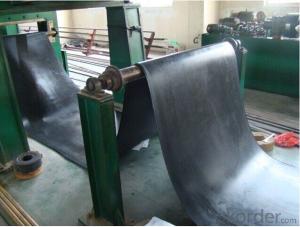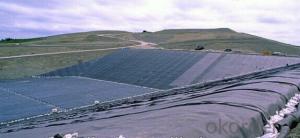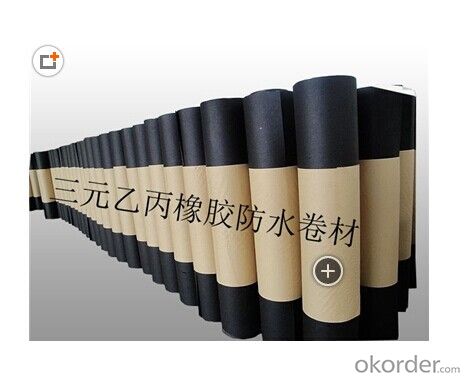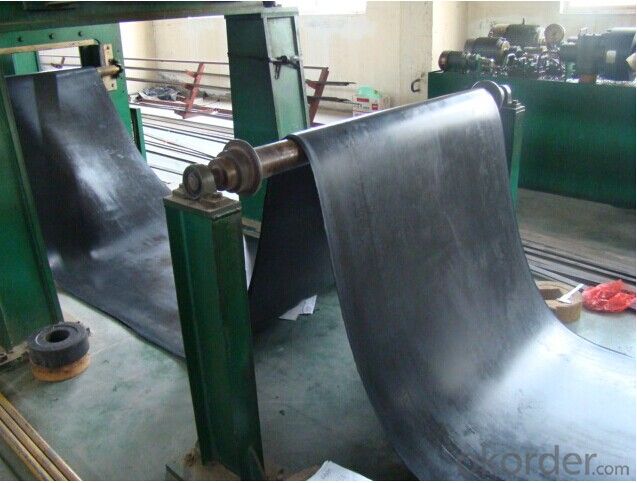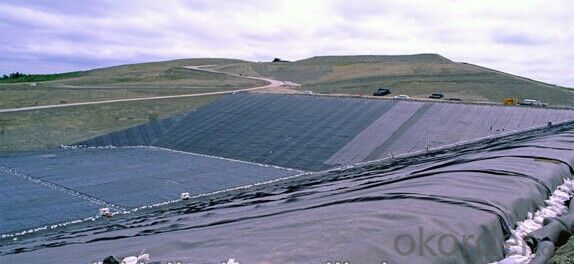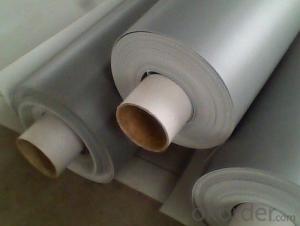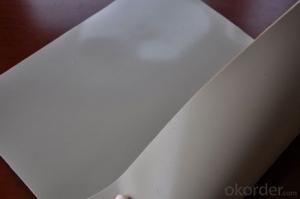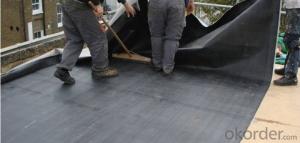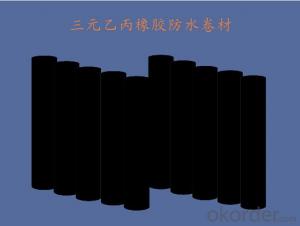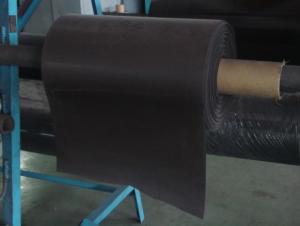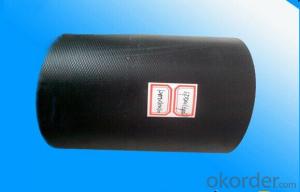EPDM Roof Waterproof Membrane with Pure Material
- Loading Port:
- Qingdao
- Payment Terms:
- TT OR LC
- Min Order Qty:
- 2000 m²
- Supply Capability:
- 300000 m²/month
OKorder Service Pledge
OKorder Financial Service
You Might Also Like
EPDM Waterproof Membrane
Introduction for EPDM Waterproof Membrane
EPDM waterproof membrane is made from ternary ethylene-propylene rubber. With the best performance among high polymer waterproof materials, EPDM is of exceptional elasticity and will not split or crack under normal building movement.
Characteristics for EPDM Waterproof Membrane
1.Excellent anti-aging performance, service life can reach 50 years;
2.High elongation, high tensile strength, heat treatment size change small;
3.Plant root penetration resistance is good
4.Good low temperature flexibility
5.Application is convenient, overlapping is firm and reliable, no environmental pollution;
6. Resistance to chemical corrosion, can be applied to special places;
7.Maintenance is convenient, the cost is low
Application for EPDM Waterproof Membrane
1) Roofs, Basement, Toilet
2) Industrial and civil building waterproofing
3) Geo-synthetic liner for swimming pool, channels, irrigation system
4) Especially suit for projects with high requirements in durability, anti-corrosion and deformation
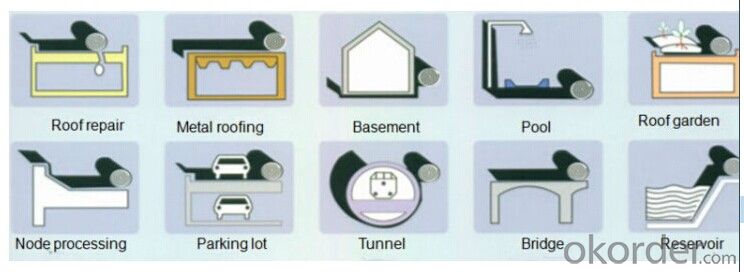
Specification for EPDM Waterproof Membrane
Item | Thick(mm) | Width | Length(m) | Color |
Spe | 1.0—2.0 | 1.2m/2m/3m/4m | 20 | Black |
Deviation | -1 +15 | --1 | Multicolor |
Technical Sheet for EPDM Waterproof Membrane
EPDM Waterproof Membrane ASTM Standard : D-7465 | ||||
Property | Test Method | Units | Mininum ASTM | |
D-7465 | ||||
Sl | Eng | |||
Specific Gravity | ASTM D-792 | gm/cc | 1.1 | 1.1 |
Unit Weight | ASTM D-751 | kg/m2 | 1.3 | 0.27 |
Thickness Type 1 | ASTM D-412 | mm(in) | 1.02 | 0.04 |
Tensile Strength. Die C | ASTM D-412 | Mpa(psi) | 9 | 1305 |
Ultimate Elongation,Die C | ASTM D-412 | % | 300 | 300 |
Tear Resistance,Die C | ASTM D-624 | Kn/m(lbf/in) | 26.27 | 150 |
Puncture Resistance | ASTM D-4833 | N(lbs) | 133 | 30 |
Shore A Durometer | ASTM D-2240 | 65-10 | 65-10 | |
Ozone Resistance | ASTM D-1149 | No Crack | No Crack | |
Multiaxial Elongation | ASTM D-5617 | % | 100 | 100 |
Heat Aging 28 days at 240 degrees | ASTM D-573 | |||
Tensile Strength, Die C | ASTM D-412 | MPa(psi) | 8.3 | 1205 |
Ultimate elongation, Die C | ASTM D-412 | % | 200 | 200 |
Tear Resistance, Die C | ASTM-624 | Kn/m(lbf/in) | 21.9 | 125 |
Accelerated Aging Xenon Arc | ASTM G-155/G-151 | Pass | Pass | |
Brittleness Point | ASTM D-2137 | -45 °C | -49 °C F | |
Water Absorption | ASTM D-471 | % | +8,-2 | +8,-2 |
Water Vapor Permeability, max | ASTM E-96 | Permils | 2.0 | 2.0 |
Linear Dimensional Change,max | ASTM-D-1204 | % | +/-1.0 | +/-1.0 |
Chronic Toxicity Screening | EPA/600/4-89/001 | Method 1000.0 | Pass | Pass |
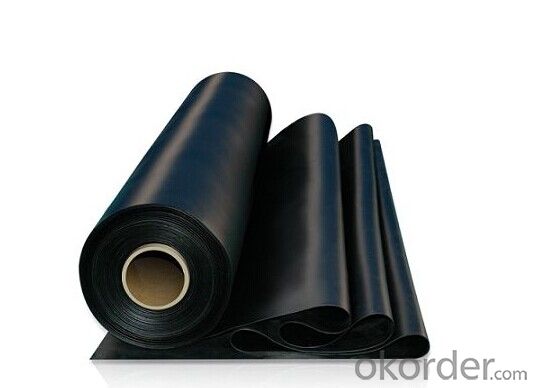

FAQ:
Can you produce 4m width?
Yes, no problem for us. We have four bases in China, largest one in this field.
How many quantity in one 20'' container for 1.2mm and 1.5mm?
480rolls, 11520m2 for 1.2mm and 400rolls, 9600m2 for 1.5mm
Can you provide free samples?
Yes, our samples are free, but express fees usually on buyer's account.
- Q: What are the requirements for the storage of waterproofing membranes?
- Stand up to release the time can not put too long or how you put the deformation will be ..... so we generally stand
- Q: Can waterproofing membranes be used on mechanical equipment rooms?
- Yes, waterproofing membranes can be used on mechanical equipment rooms. Waterproofing membranes are commonly used to protect various types of structures, including mechanical equipment rooms, from water damage. These membranes create a protective barrier that prevents water infiltration, ensuring the longevity and proper functioning of the equipment and reducing the risk of water-related issues such as corrosion or electrical damage.
- Q: DTM.E polyester composite waterproofing membrane, cheaper than the asphalt membrane?
- Ouwei Jianke DTM.E polyester composite waterproofing membrane is the company according to GB50207-2002 "roofing quality acceptance norms", GB50108-2008 "underground engineering waterproof technical specifications", GB50208-2002 "underground waterproofing project quality acceptance norms" and Other waterproof engineering design Widely used in a new type of waterproof material,
- Q: Can a waterproofing membrane be customized or tailored to specific project requirements?
- Indeed, specific project requirements can be met through the customization or tailoring of a waterproofing membrane. There are various types and materials available, including bituminous, synthetic, and liquid-applied membranes. These membranes can be adjusted or modified to suit the particular needs of a project. Customization involves factors such as the thickness or weight of the membrane, the type of reinforcement utilized, the application method, and the project's specific performance requirements. For instance, heavy traffic areas may require a thicker or more durable membrane to withstand substantial loads, while projects in harsh climates may necessitate a membrane with enhanced resistance to UV radiation or extreme temperatures. Moreover, the membrane can be tailored to different substrates or surfaces, such as concrete, metal, or wood, by utilizing compatible adhesives or primers. This ensures proper bonding and extends the lifespan of the waterproofing system. Furthermore, certain waterproofing membranes offer customizable options for color or appearance, enabling them to seamlessly blend with the overall aesthetic of the project. In conclusion, the customization of a waterproofing membrane allows for its specific design and engineering to cater to the unique requirements of each project. This ensures optimal performance and long-lasting protection against water damage.
- Q: Can a waterproofing membrane be applied over cracks or joints in a surface?
- Yes, a waterproofing membrane can be applied over cracks or joints in a surface. In fact, it is often recommended to do so in order to ensure a complete and effective waterproofing system. The membrane acts as a barrier that prevents water from seeping through the cracks or joints and causing damage to the underlying structure. However, it is important to note that the cracks or joints should be properly repaired and prepared before applying the waterproofing membrane. This may involve cleaning, filling, and sealing the cracks or joints to ensure that the membrane adheres properly and provides a continuous and watertight seal. Additionally, the type of waterproofing membrane used should be selected based on the specific requirements and conditions of the surface being treated.
- Q: Can a waterproofing membrane be used in conjunction with warranty or insurance policies?
- Yes, a waterproofing membrane can typically be used in conjunction with warranty or insurance policies. Many waterproofing products and systems come with warranties that provide coverage for a certain period of time, typically ranging from 5 to 20 years or more. These warranties often guarantee the effectiveness and durability of the waterproofing membrane, and may cover repairs or replacements in case of any failures or defects. Additionally, insurance policies may also provide coverage for damages caused by water leaks or flooding. By installing a waterproofing membrane, property owners can mitigate the risk of water damage and potentially reduce their insurance premiums. It is advisable to check with your insurance provider to determine if they offer any discounts or incentives for using waterproofing systems. However, it is important to note that the coverage provided by warranties and insurance policies may vary depending on the specific terms and conditions. It is recommended to carefully review the details of the warranty or insurance policy and consult with professionals to ensure that the waterproofing membrane meets the requirements and specifications outlined by these agreements.
- Q: Can a waterproofing membrane be used on tunnels with pedestrian traffic?
- Tunnels with pedestrian traffic can indeed utilize a waterproofing membrane. Such membranes are frequently employed in subterranean structures, such as tunnels, to avert water infiltration and safeguard the structure against water-related harm. Generally, these membranes are applied to the outer walls and floors of the tunnel, thereby forming a barrier against water penetration. They are engineered to endure the weight of traffic and provide long-lasting protection against moisture. Furthermore, certain waterproofing membranes possess anti-slip characteristics, ensuring the safety of pedestrians traversing the tunnel. All in all, employing a waterproofing membrane on tunnels with pedestrian traffic constitutes an effective approach to bolster the longevity and safety of the structure.
- Q: Can a waterproofing membrane be used in interior or exterior applications?
- Yes, a waterproofing membrane can be used in both interior and exterior applications. It is commonly used in basements, bathrooms, and other areas prone to moisture and water infiltration. Additionally, it can also be applied to exterior surfaces such as foundations, roofs, and balconies to prevent water damage and maintain the integrity of the structure.
- Q: Can a waterproofing membrane be used on aluminum surfaces?
- Yes, a waterproofing membrane can be used on aluminum surfaces.
- Q: Does a waterproofing membrane require a primer before application?
- In order to apply a waterproofing membrane, it is necessary to use a primer. The purpose of a primer is to improve the adhesion between the membrane and the substrate, guaranteeing a strong bond. Additionally, it acts as a sealant that protects the surface, preventing any moisture or impurities from affecting the efficiency of the waterproofing system. For a reliable and enduring waterproofing solution, it is crucial to apply a primer prior to the membrane.
Send your message to us
EPDM Roof Waterproof Membrane with Pure Material
- Loading Port:
- Qingdao
- Payment Terms:
- TT OR LC
- Min Order Qty:
- 2000 m²
- Supply Capability:
- 300000 m²/month
OKorder Service Pledge
OKorder Financial Service
Similar products
Hot products
Hot Searches
Related keywords


